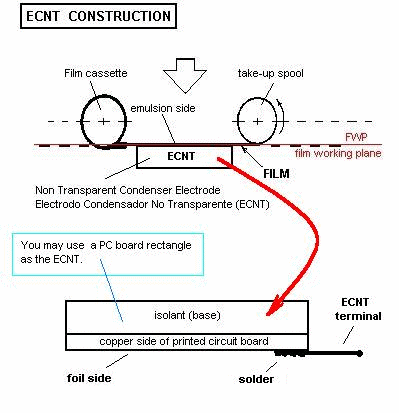



The general arrangement of film cartridge position, dielectric separator and active electrode is given in the following drawing:

As we can see, the film slides smoothly over the ECNT (Non Transparent Condenser Electrode), without any curvature, thus remains flat over a flat surface, minimizing air trapping between itself and the ECNT working surface.
The distance between the FWP (Film Working Plane) and the imaginary plane formed by the film cassette and the spool centers it's not arbitrary; it is given by the general film cassette dimensions. Therefore, when designing or modifying any camera, this distance must be observed.
This simple precaution prevents any deformation that eventually may appear. Preventing this deformation we help minimize the air gap between the lower film surface and the ECNT upper surface. This two measures combined certainly will assure that the film stays flat when the finger press against it, minimizing any under-the-film discharge that may occur.
Usually advertised Kirlian cameras fail entirely to fulfill these simple precautions. In my point of view, faulty designs regarding this aspect are responsible for many of the typical images observed.

Here, in a faulty design, when we use color films, we see the
formation of two microcavities of trapped air .
Inside we may have some
streamers, thus the lower red-sensitive layer
may be exposed, producing all-red streamers
(even though there were no "red streamers" at all!).

In the central region, where streamers enter the upper blue-sensitive layer, the predominant color is
blue.
It's obvious that if we prevent
the formation of streamers under the film, the predominant colors will be blue and white.
A beautiful example of the previous considerations are verified using the following scheme:
With a faulty camera design, we pick a new film cassette. In a dark room we unreel the film and proceed to reel it again, but this time with the emulsion turned to the other side, thus, when the cassette is loaded in the camera, the emulsion side will no longer be in contact with the finger but in contact with the ECNT surface.
Thus, the central streamers over the film will now expose the central region, which now has the red-sensitive layer toward them. The streamers appearing under the film inside the K1 and K2 cavities, will now expose the blue layer of the emulsion, and will appear as a bluish diffuse light.
This film inversion will produce an inverted pattern of colors in relation with the normal pattern obtained when the emulsion is in contact with the finger (emulsion "up" scheme).
The following pictures were obtained following the procedures depicted above:
 |
 |
 |
A simple experiment can be made to simulate these cavities under the film. This air pockets will produce under-the-film streamers which in turn will expose the lower red sensitive layer.
 |
 |
 |
If the air trapped in these pockets suffers ionization, we may have a secondary corona under the film. These streamers will travel then trough the antihalation coating (which is translucent) and expose de red-sensitive layer of the emulsion. Here, two important considerations must be made:
First, being the antihalation coating translucent, we may obtain some light diffusion in the transparent film base. This reduces the sharpness of the secondary corona.
Second, as the red-sensitive layer has a different sensitivity from others layers (because the film was designed and adjusted to deal with light impinging from the emulsion side), the overall response to light (mainly blue and uv) will be difficult to estimate, i.e.: How will this red-sensitive layer respond?
A classical example of the points mentioned above is given by the following picture:

Summary
These experiments were designed to prove certain points I've had in mind regarding the so called Kirlian Photography. I have always thought that there were many obscure points that were never mentioned in many classical books written about the phenomena., therefore I proceeded inspired in what I thought were the real variables working behind the scene. Years after proving myself that I was right about my observations, I came across three publications which gave full support to my own observations.
Kirlian photography in theory and clinical application
Image Modulation in Corona Discharge
Photography, by John O. Pehek, Harry J. Kyler and David L. Faust.
Science, 15 October 1976, Volume 194, Number 4262.
Although I do not agree entirely with their claim that moisture
is a principal determinant of the form and color of Kirlian photographs of
human objects, they verified that secondary images are produced inside air
pockets under the film as mentioned above.
Corona Discharge
Photography, by David G. Boyers and William A. Tyler. Journal of
Applied Physics, Volume 44, Number 7, July 1973.
In this paper the authors made an exhaustive investigation,
and a comprehensive study of color film construction and its behavior under
this type of photography. Again, their results agree with all authors
mentioned above and myself, concerning under the film
discharges.
It obvious to me that the use of color film under the current Kirlian technique was never intended by the photographic laboratories who manufacture these films. They were designed to work with light in a certain way, which means with light arriving at certain angles and from a particular direction. Any deviation from this original working parameters may certainly introduce unknowns that render the current images obtained useless from a scientific point of view. Therefore I have serious doubts about the claims of certain researchers when they say they've found certain "formations" that regularly appear when the subject suffers a particular disease, particularly those claims relating certain color formations to a particular disease. I would like to see many of these "loose ends" in their work really tied up before taking their claims seriously.
Original Document at: http://www.geocities.com/lemagicien_2000/kfpage/falseimage/falseimage.html